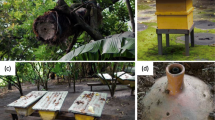Abstract
The economic viability of the wildlife based enterprises (bee-keeping and caterpillar utilization) in Malawi is discussed in relation to conventional agricultural enterprises (maize, beans and ground-nuts). A strong incentive emerges for rural people to adopt wildlife management as an adjunct to subsistence agriculture, and therefore, to promote conservation of natural ecosystems and wildlife habitats in the face of growing human population and demand for land. Dependence on agriculture has depleted the wildlife resource outside protected areas and has been less effective in improving the wealth and living standards of most rural people. This study illustrates that the Malawi Department of National Parks and Wildlife needs to introduce economic incentives that integrate biological conservation with economic development for the rural people. The management programme involves the adoption of a rotation burning policy that promotes vegetation coppicing, eases harvesting and promotes high caterpillar yields.
Similar content being viewed by others
References
Anonymous (1988)Southern African Development Co-ordination Conference Regional Economic Survey. SADCC Secretariat Gaborone, Botswana.
Anonymous (1991a)Food Security and Nutrition Survey. Kasungu Agricultural Development Division, Malawi. Seminar paper.
Anonymous (1991b)Guide to Agricultural Production in Malawi, 1990–91. Extension Aids Branch, Lilongwe, Malawai, pp. 114–5.
Anonymous (1991c)The Role of Non-governmental Organisation in promoting Agricultural Development and Natural Resources in Malawi. Experiment in International Living. USAID/SHARED workshop Report, pp. 25–26.
Bell, R.H.V. and Jachmann H. (1974) Influence of Fire on the use ofBrachystegia Woodlands by Elephants.African J. Ecol. 22, 157–63.
Deodatus, F.D. and Lipiya, A.K. (1991) Vertebrate Pest Impact Around Kasungu National Park.FAO Field Document 10, pp. 4–6.
Ellis, F. (1988)Peasant Economics. Farm Households and Agrarian Development. Cambridge, UK: Cambridge University Press.
Kaiser, K. (1992) Unpublished.
Mackinon, J., Mackinon, K., Child, G. and Thorsell, J. (1986)Managing protected areas in the Tropics (J.A. McNeeley and K.R. Miller, eds). Switzerland: IUCN.
Malik, H.J. and Mullen, K. (1973) A first course in Probability and Statistics. Ch. 10. Addison-Wesley Publishing Company: Canada.
Munthali, S.M. (1990)Wildlife Based Tourism in Malawi. Proceedings of the Wildlife-Based Workshop. SADCC/GTZ workshop, Kafue, Zambia, pp. 30–51.
Roberts, D.J. (1973)Farm Management Handbook. Extension Aids Branch, Lilongwe, Malawi.
Seubert, C. and McKay, K.L. (1989) Natural Resources Support Project Report, Malawi, pp. 8–9.
Siegel, S. and Castellan, N.J. (1988)Non-parametric Statistics for the Behavioural Sciences, Ch. 7. McGraw-Hill International Edition, USA.
Skaife, S.H. (1979)African Insect Life. Capetown/Johannesburg: C. Struik Publishers, pp. 177.
Author information
Authors and Affiliations
Rights and permissions
About this article
Cite this article
Munthali, S.M., Mughogho, D.E.C. Economic incentives for conservation: beekeeping and Saturniidae caterpillar utilization by rural communities. Biodivers Conserv 1, 143–154 (1992). https://doi.org/10.1007/BF00695912
Received:
Revised:
Accepted:
Issue Date:
DOI: https://doi.org/10.1007/BF00695912



